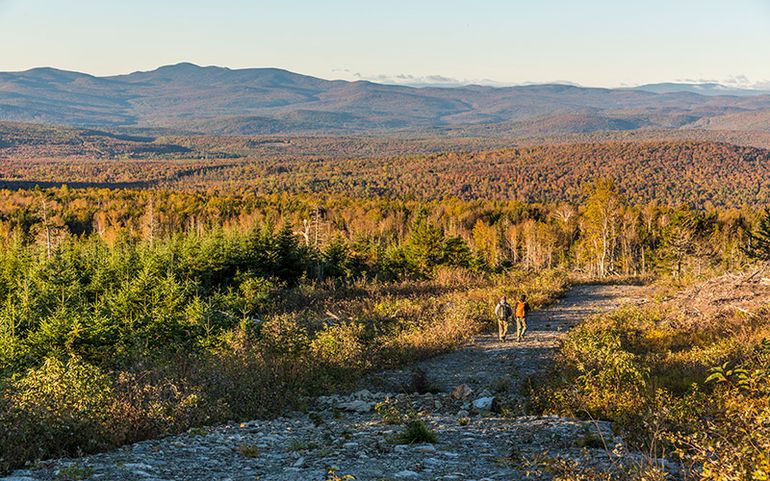
Conservation deal protects 10,000 acres in Western Maine
 Courtesy / The Trust for Public Land
The 1,155-acre Lone Mountain conservation easement will be held by the U.S. Navy but will preserve public access to hiking trails, under conservation easements secured by The Trust for Public Land in partnership with the Navy and the Maine Appalachian Trail Land Trust.
Courtesy / The Trust for Public Land
The 1,155-acre Lone Mountain conservation easement will be held by the U.S. Navy but will preserve public access to hiking trails, under conservation easements secured by The Trust for Public Land in partnership with the Navy and the Maine Appalachian Trail Land Trust.
The Trust for Public Land, partnering with the Maine Appalachian Trail Land Trust and the U.S. Navy, announced that more than 10,000 acres along the Appalachian Trail in the mountains of Western Maine will be protected through conservation easements acquired on two properties.
The majority of funding for the acquisition of the conservation easements came through the U.S. Navy and the Readiness and Environmental Protection Integration Program.
The two properties are adjacent to a Navy remote wilderness training facility. Protection of these tracts prevents incompatible development that could negatively affect the military’s training goals and overall readiness. The REPI program is geared to ensuring dual military and conservation successes in communities surrounding installations.
The 9,580-acre Redington Forest conservation easement will be co-held by the Maine Appalachian Trail Land Trust and the U.S. Navy. The 1,155-acre Lone Mountain conservation easement will be held by the U.S. Navy.
Additional support for the Redington Forest project came from the Elmina B. Sewall Foundation, Open Space Institute’s Transborder Fund and Summer Hill Foundation.
Protecting public access

In its news release, The Trust for Public Land said the conservation easements on the two properties will keep them forever open to the public for hiking, fishing, snowmobiling and hunting — adding that it “will also help to support Western Maine’s growing outdoor recreation economy.”
Large portions of the land will continue to be managed as a working forest to support Maine’s timber economy while also providing clean water and wildlife habitat, including the Northeast’s most imperiled songbird, the Bicknell’s thrush.
“When you’re hiking in these mountains, it’s easy to think that the views and remote experiences we have will always be there for us,” said Betsy Cook, project manager for the Trust for Public Land. “But the reality is that much of land is still vulnerable to drastic change or lack of public access.”
Although almost the entire Appalachian Trail footpath is protected, much of the adjacent land is still very vulnerable to development. Protection of the Lone Mountain and Redington Forest properties, the trust stated, will help “to protect a hiker’s experience along the Appalachian Trail, through some of Maine’s highest peaks.”
Capt. David Hunt, commander of the Portsmouth Naval Shipyard, said the project was an ideal candidate for the Navy’s REPI program, since it allows the Navy to maintain “a realistic training environment while also conserving land which supports the public’s continued enjoyment of the wilderness experience. We will all benefit from its successful conclusion now and in the future.”
A collaborative effort
The Trust for Public Land said the newly conserved 10,000 acres adds to earlier initiatives to protect land along Appalachian Trail in Western Maine — including neighboring Crocker Mountain (12,046 acres) in 2013, nearby Orbeton Stream (5,774 acres) in 2014 — and will continue to build upon years of work to expand the conservation corridor of the Appalachian Trail, from Maine to Georgia.
“Protection of Redington Forest and Lone Mountain also knits together about 60,000 acres of protected land in an ecological corridor that is critically important for wildlife movement,” the trust stated.
Simon Rucker, executive director of the Maine Appalachian Trail Land Trust, said his organization was pleased to be the holder of the conservation easement for the 9,580 acre Redington Forest, which he noted will remain a working forest and provide a “valuable buffer for one of the most remote and scenic stretches of the Appalachian Trail
“The Appalachian Trail landscape is rich in recreational values, ecological connectivity and economic development opportunities,” he said. “Protection of these lands helps to further all three.”
Nancy Perlson, a resident of Madrid, Maine, and former executive director of the Rangeley Lakes Heritage Trust, said the conservation easements were the result of collaborative effort among multiple partners.
“The conservation of Redington Forest represents a collaboration of local, regional, and national interests," she said. “The Trust for Public Land and Maine Appalachian Trail Land Trust brought tremendous expertise to this complex transaction while ensuring that local voices were heard and that locally important recreational trails on the property were protected.”










Comments